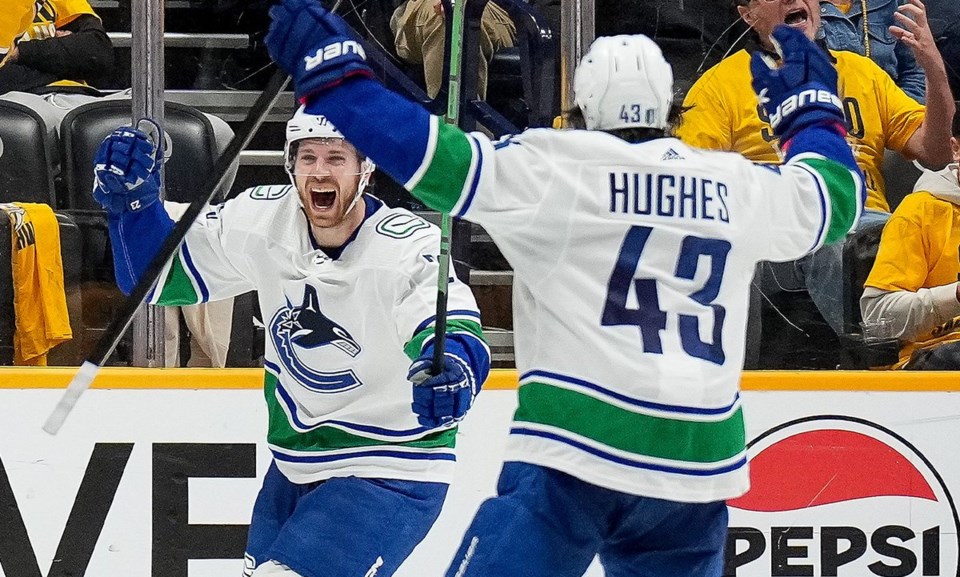Game 4 was over. The Nashville Predators had a two-goal lead late in the third period and a stranglehold on puck possession, giving the Vancouver Canucks nothing to work with. It seemed unlikely that the Canucks could get two shots on goal in the final three minutes, let alone two actual goals.
That’s what made the Canucks comeback so incredible in the original sense of the word. It was impossible to believe that they actually did it. If you had stopped watching that game with three minutes left and another fan told you the Canucks came back to win the game, you would dismiss that fan, saying, “That guy just isn’t credible.”
But they did it.
Brock Boeser scored two goals in the final three minutes of regulation, Colton Sissons hit the post on an empty net, and Elias Lindholm ended it in overtime.
The Canucks played one of their worst games of the season and it somehow turned into one of the greatest games in franchise history. It’s funny how the playoffs work.
It was a madcap four minutes of action and it deserves a proper breakdown, which means it’s time for a fan-favourite feature here at Pass it to Bulis: Breakdowning.
Brock Boeser kicks off the comeback
With three minutes left in the third period, the Canucks have pulled Arturs Silovs for the extra attacker. They’ve gained the zone in an unorthodox but onside manner — Elias Pettersson hit J.T. Miller in the back with his attempted dump-in and the puck bounced into the middle of the ice where Filip Hronek retrieved it.
Let’s take roll call.
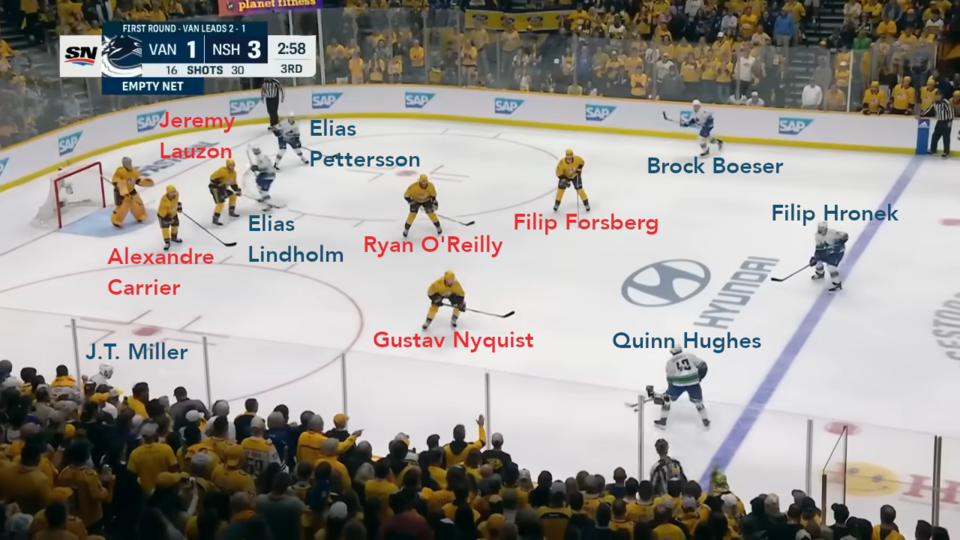
The Predators have their top line of Gustav Nyquist, Ryan O’Reilly, and Filip Forsberg on the ice, with their second pairing of Jeremy Lauzon and Alexandre Carrier on defence. This is their shutdown pair — more defensively reliable than Roman Josi’s top pair.
With the net empty, the Canucks have all of their stars on the ice: the Lotto Line of Brock Boeser, Elias Pettersson, and J.T. Miller and their top pair of Quinn Hughes and Filip Hronek, with Elias Lindholm as the extra attacker.
The Canucks have spread the ice as much as possible to try to take advantage of the 6-on-5, while the Predators are in pseudo-penalty killing formation, with one-time Selke winner O’Reilly locking down the middle of the ice.
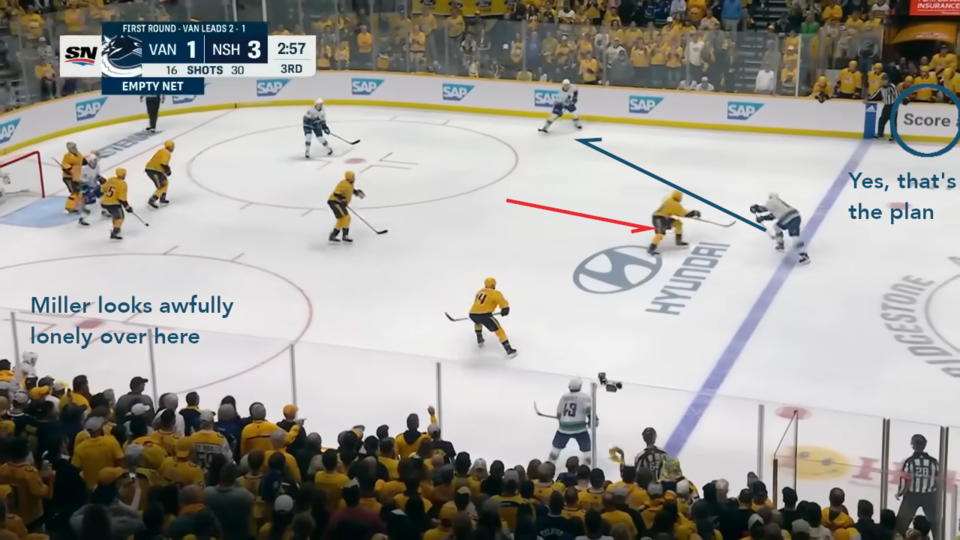
Here’s where things start to go wrong for the Predators.
Nyquist gives Hughes a respectable amount of distance at the point, just as the Predators have done all series. He definitely does not want to overcommit and be made to look like a fool by Hughes’ elite stickhandling and skating — THIS IS FORESHADOWING.
But when Hughes moves the puck to Hronek, Forsberg dives in like Laso Schaller, looking to pressure Hronek into a turnover. But Hronek is calm and confident with the puck and quickly moves it to Boeser on the far boards.
Forsberg’s dive in, however, opens up some space and forces a defensive rotation for the Predators.
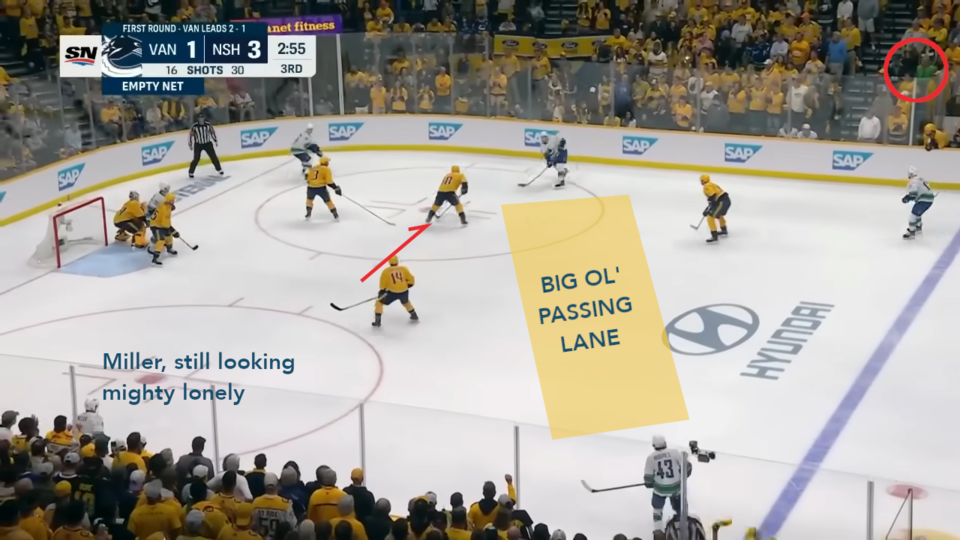
O’Reilly is forced out of the slot to challenge Boeser, leaving Nyquist to rotate down into the slot to ensure the guts of the ice are covered. Forsberg being so high in the zone opens up a big ol’ passing lane back to Hughes, who now has acres of space at the point thanks to Nyquist moving down.
There’s a random fan in a puffy green vest in the crowd, which is a weird choice. Someone else in green is going to show up later. What’s the deal?
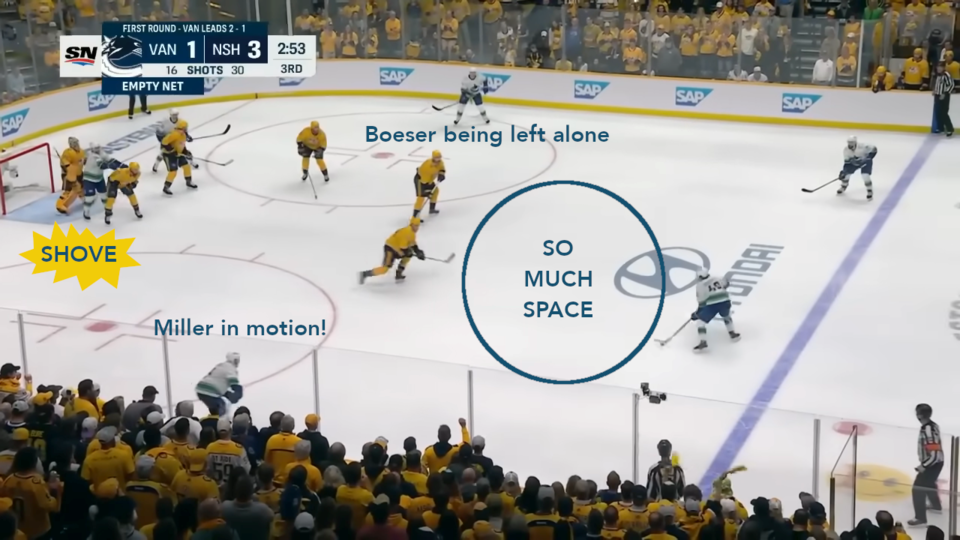
Hughes uses the space given to him to move into the middle of the ice as the Predators’ forwards collapse back to the middle, with O’Reilly leaving Boeser at the far boards to cover the rails.
In front of the net, Lindholm pushes off Carrier to give himself a little more room. Pettersson, meanwhile, starts to move into the slot.
On the near boards, Miller, after staying as still as possible so the Predators couldn’t see him — their vision is based on movement — darts to the top of the left faceoff circle. The Canucks are about to run one of their go-to plays on the power play. Sort of.
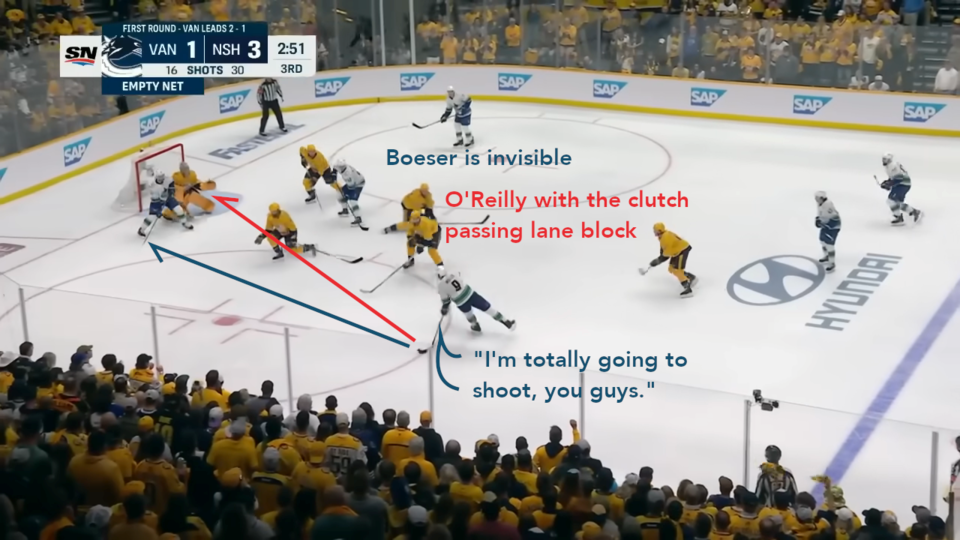
The Canucks love to have Miller coming downhill on the left side on the power play, looking to either shoot or send a pass into the bumper and the concept is essentially the same at 6-on-5. Miller even scored on this exact shot in Game 3, firing a puck glove side past a screened Saros.
That’s why it makes perfect sense for Carrier to leave Lindholm and go for the block. Forsberg too comes across to get his stick in the lane, while O’Reilly gets his stick down to take away the cross-seam pass to Boeser.
Pettersson is there in the slot to clean up a potential rebound or tip in a slap pass, so Lauzon preemptively moves out to cover him, ready to tie up his stick.
The red line is where the Predators are expecting the puck to go and for good reason: Miller is facing the goal, has his leg kicked to give himself extra torque on his stick for a wrist shot, and he’s only got eyes for the net. But the blue line is where the puck is actually going to go, as Miller executes a beautiful no-look pass.
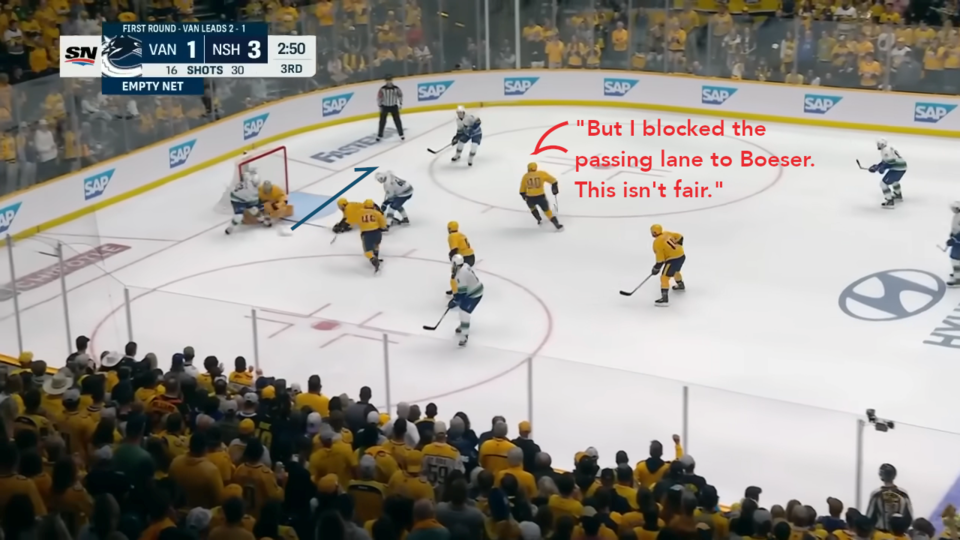
Here’s the consequence of the Predators trying to front every shot: there’s suddenly a 3-on-1 down low.
Lauzon does his best to take away both Pettersson and the passing lane but can’t get his stick down in time. Lindholm slips the puck underneath his stick to Boeser at the backdoor. Despite a brief bobble, Boeser remains poised and deposits the puck in the net.
Here’s another look at the key moment for this goal:
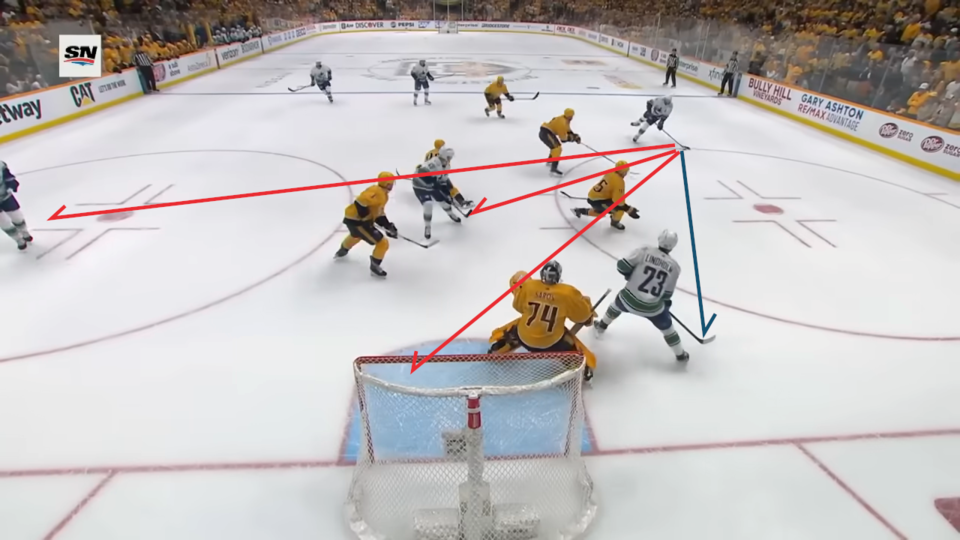
Miller has four options from the top of the faceoff circle here: he can try to pass across to an open Boeser; he can try a slap pass to Pettersson for the tip; he can try to shoot; or he can pass it down low to Lindholm.
The Predators take away three of those four options: O’Reilly is in the lane to Boeser; Forsberg is in the lane to Pettersson, with Lauzon ready to tie up Pettersson’s stick; and Carrier is in the shooting lane to the net.
That leaves just one option but because Carrier has committed to the shot block, it’s a very good option.
Colton Sissons hits the post
After Boeser got the comeback started, it nearly came to an abrupt end, as Colton Sissons came agonizingly close to scoring into the empty net.
There’s not a lot to break down here, so we won’t spend a lot of time on it, but it’s a crucial part of the comeback story.
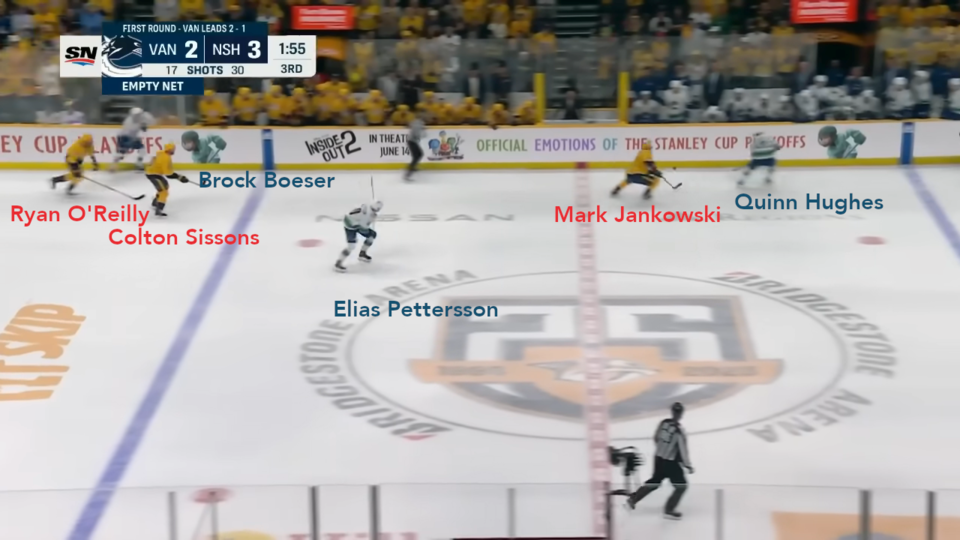
We’ve got a briefer roll call here, as there are fewer players involved. O’Reilly is on the ice again, beating Boeser to a puck at the far boards and forcing it up ice.
Hughes would typically pick up this puck and circle back in the zone but he’s pressured by Mark Jankowski and chips it up the boards instead. Unfortunately, that’s where Colton Sissons is lurking.
Luckily for Hughes, Pettersson is hustling back on the backcheck.
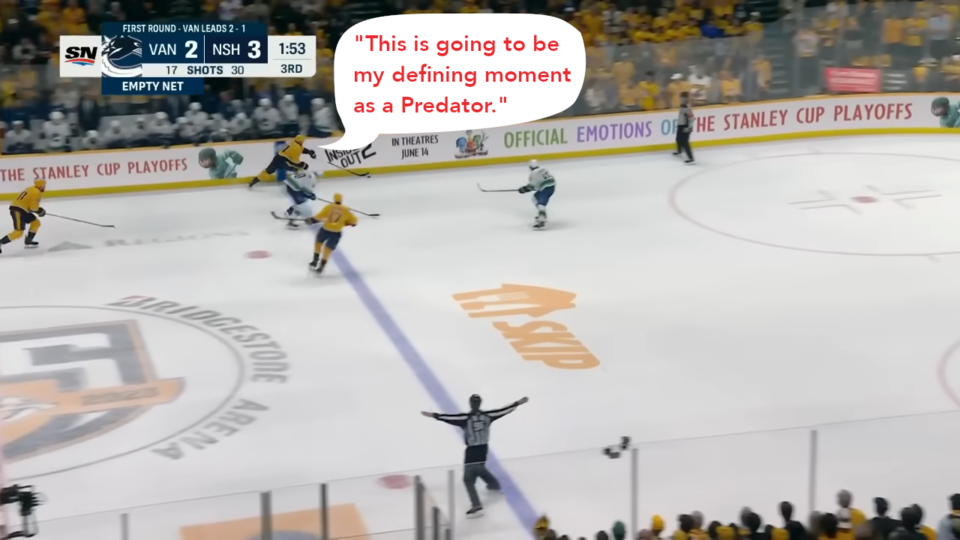
Sissons picks off the puck and bursts up the left wing, with Pettersson keeping pace with him.
Hughes backs off, trying to keep in range to potentially knock down Sissons’ attempt at the empty net with his stick while also taking away a pass to Jankowski in the middle.
All Sissons has to do, however, is just hit an empty net. No big deal.
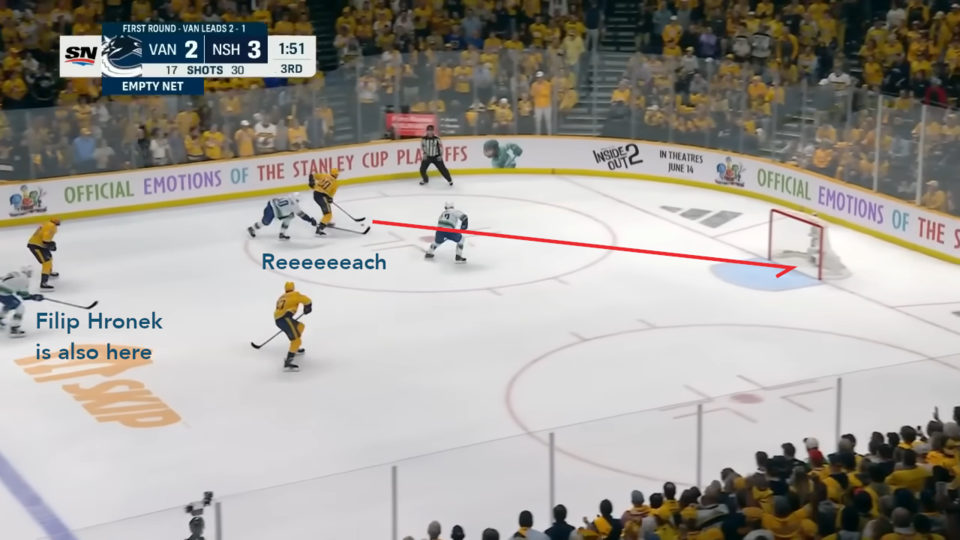
The trouble for Sissons is that he has to hit the empty net on the backhand, as the backchecking Pettersson reaches in and disrupts any opportunity for him to take the puck to his forehand.
Across his ten seasons in the NHL, Sissons has scored 11 goals on the backhand on 102 shots on goal — a shooting percentage of 10.8% — compared to 68 goals on the forehand. Heading into Sunday night, he’d hit 25 posts or crossbars in his career, both in the regular season and playoffs.
Forced onto his backhand, Sissons hit one more post.
On the bench, Sissons’ teammates celebrated, assuming there was no way he could miss the empty net. All of them realized a moment later that he had hit the post, except for Cole Smith.
The puck rebounded off the post to Hughes and he iced the puck, grateful that the game wasn’t over.
Brock Boeser’s game-tying goal
With another lease on life after the Sissons miss, the Canucks once again pulled Silovs for the extra attacker and moved up ice. This time, they had a slightly different cast of characters, so let’s take roll call again.
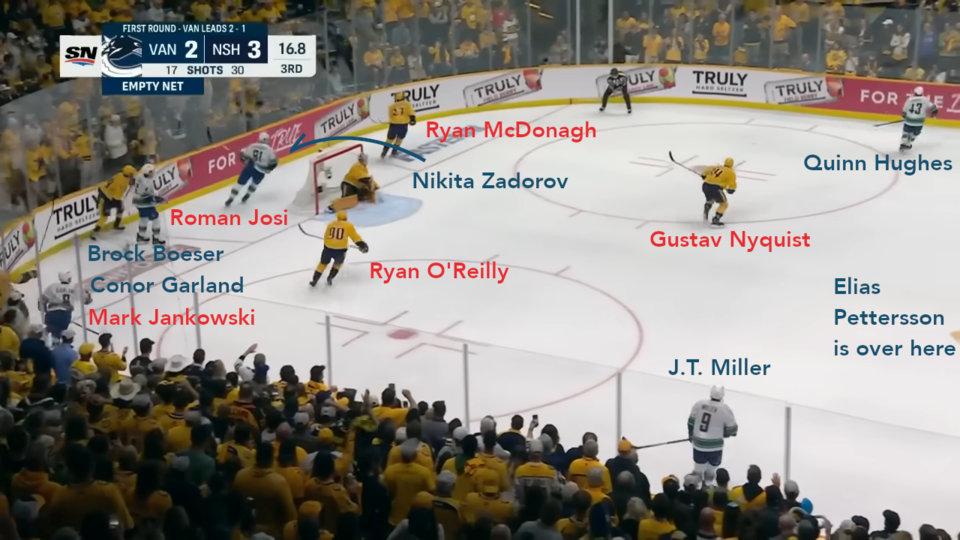
Despite getting the assist on Boeser’s previous goal, Lindholm isn’t on the ice. Instead, Conor Garland is the extra forward with the Lotto Line. Meanwhile, Hronek has been replaced by Nikita Zadorov but not to play at the point. Instead, the gigantic Zadorov is the net front presence.
The Predators have O’Reilly on the ice once again, with Nyquist and Jankowski on his wings. On defence, it’s Josi and McDonagh.
Jankowski has just won a battle in the corner with Garland — no mean feat — and moved the puck down low to Josi, who fired it around the boards. Hughes, however, is waiting for the puck, ready to pick it up on his backhand.
The puck takes a weird carom off the boards, so it never arrives on Hughes’s backhand but he adjusts quickly, knocks the puck down, then sends the overcommitted Nyquist spiraling into the shadow realm with a deft deke. This is why you don't overcommit, Nyquist. Why didn't you listen to my foreshadowing earlier?
Abandon your gods, Nyquist, for they have surely abandoned you.
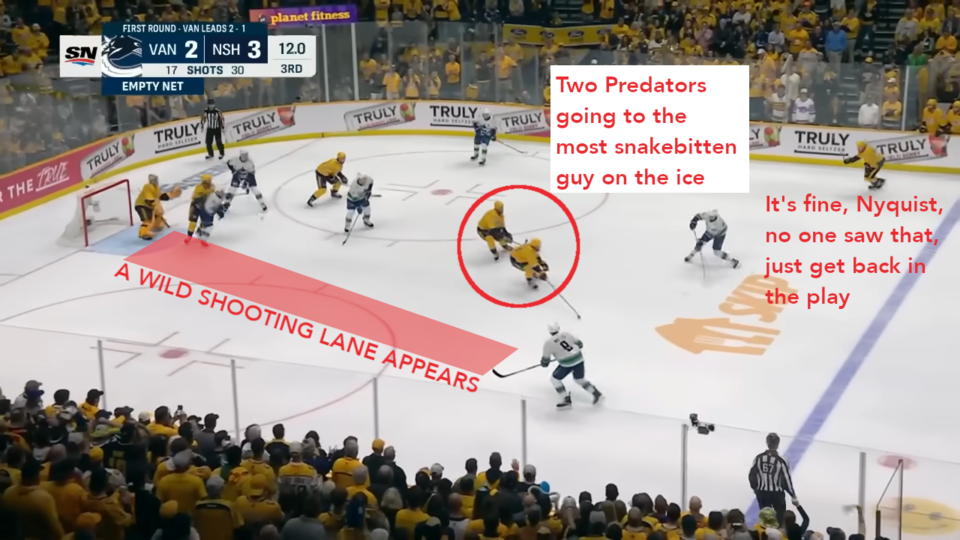
With Nyquist down and out, it becomes a 6-on-4 for the Canucks. Hughes moves the puck to Pettersson at the point with 13 seconds left in regulation but Pettersson doesn’t panic. Instead, he waits a beat to draw in two Predators — O’Reilly and Jankowski — before passing the puck to Miller.
Once again, Miller is coming downhill at the top of the left faceoff circle, only this time he has a wide-open shooting lane.
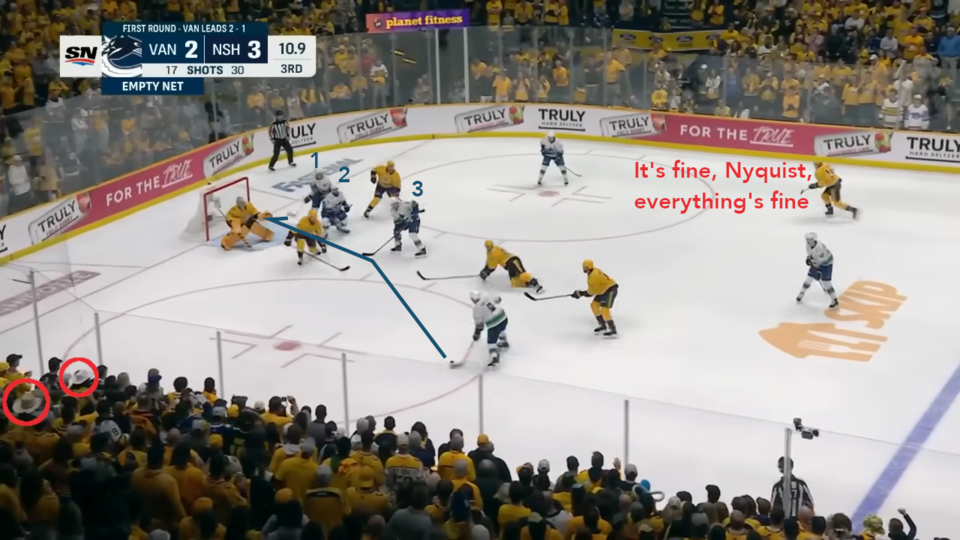
So, of course, Josi comes out to try to block the shot, leaving Garland (and Zadorov) behind him. It’s been the Predators’ strategy all series.
With the direct shooting lane to the far post blocked and Saros watching the near post, Miller instead looks for Boeser in the slot, hoping for a deflection on net.
The big thing to notice here, however, is that the Canucks now have three skaters with inside position on McDonagh: Zadorov, Garland, and Boeser. With Josi selling out for the shot block, the Predators have to hope there’s no rebound, because the Canucks have the clear advantage.
Also, I circled a couple of cowboy hats in the crowd. Cowboy hats are pretty cool.
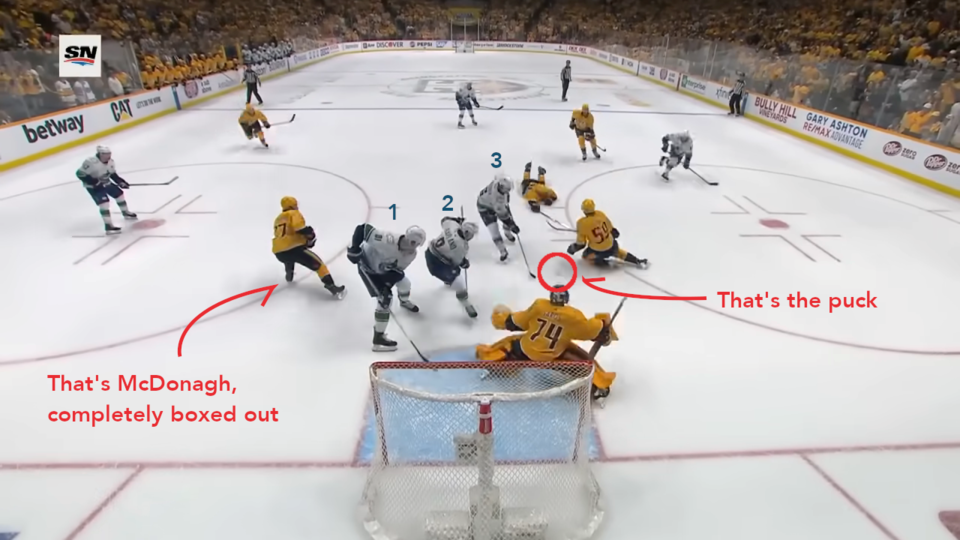
Josi charges out and smartly gets his stick in the middle of the ice, recognizing the danger of the slap pass. He gets a piece of the puck but only a piece, allowing the puck to still get through to Saros.
That’s bad news for the Predators, as the Canucks have a wall of bodies between the nearest defenceman, McDonagh, and the puck.
Josi is on the ice. O’Reilly dove out to try to block the slap pass, so he’s down and out too. Nyquist is still miles away.
Boeser is the nearest man to the puck. All he has to do is tuck it around Saros.
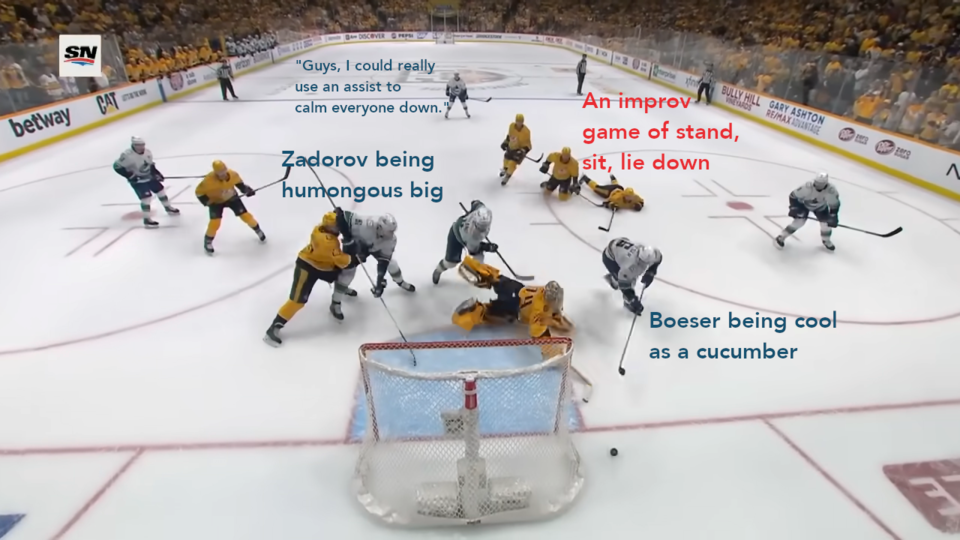
Boeser misses the net.
To be fair, he had to reach for the puck on his backhand after pulling it away from Saros and it rolled off the toe of his blade. But Boeser is an experienced, 40-goal-scoring veteran now. He shows no panic whatsoever.
In front of the net, Zadorov boxes out McDonagh on account of his bigness.
Meanwhile, Jankowski, O’Reilly, and Josi play an impromptu improv game — the classic game of stand, sit, lie down.
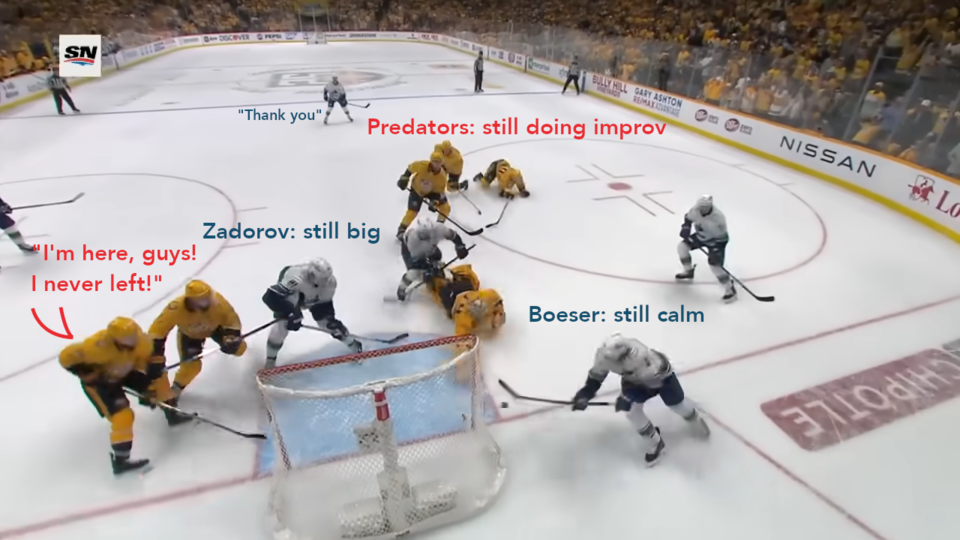
Nyquist finally gets back in the play, sort of. But, because Zadorov is all kinds of big and has boxed out McDonagh, Nyquist can’t get past the two of them to get into the crease. He still gets his stick on Boeser’s shot but it’s after the puck is already over the goal line.
That’s all Zadorov’s doing. Well, him and Hughes, who deked Nyquist into nonexistence in the first place.
All that was left was the jubilation.
Well, that and overtime.
Elias Lindholm wins it in overtime
Riding the emotional high of their comeback in regulation, the Canucks wasted no time winning the game, scoring just 1:02 into overtime.
Let’s kick things off with a roll call.
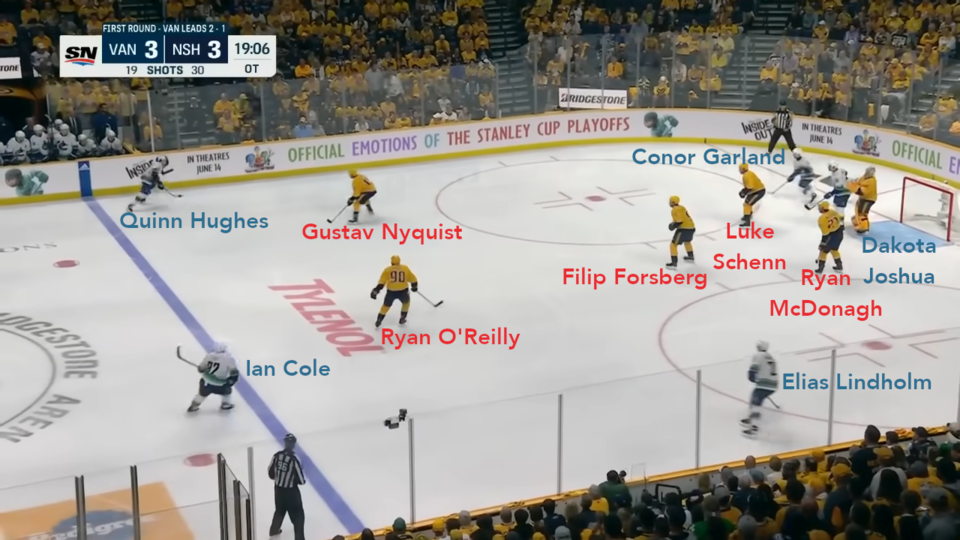
It’s the second shift of overtime, with both teams having executed a full line change. In fact, the Canucks have cycled through two defence pairs already: Carson Soucy and Tyler Myers started overtime, were replaced by Nikita Zadorov and Ian Cole, then Quinn Hughes came out on the third rotation — that in itself is pretty intriguing.
The Canucks have their third line with Dakota Joshua and Conor Garland flanking Elias Lindholm, with Hughes alongside Cole, who hadn’t gotten off the ice yet for Filip Hronek.
The Predators, meanwhile, have their first line on the ice — Filip Forsberg, Ryan O’Reilly, and Gustav Nyquist — with bottom pair Luke Schenn and Ryan McDonagh on defence.
One of the key things to notice here is that Forsberg, typically the winger on his line, is playing as the centre in this moment. As the first forward back (F1) when the Canucks entered the zone, guarding the middle of the ice is his responsibility, which is why he’s on the “rails” between the hashmarks.
Because Forsberg is playing a zone defence rather than man-to-man, that leaves Lindholm open but that’s fine for the Predators. They want to protect the middle of the ice, get in passing and shooting lanes, and leave the perimeter to the Canucks.
But before we go any further, let’s back things up to 20 seconds earlier, where Brock Boeser made a key play.
Boeser, already with a hat trick, didn’t make it onto the scoresheet for the overtime goal but this takeaway in the neutral zone on Forsberg is crucial. Boeser turns the puck back up ice where it’s forced into the Predators’ zone by Joshua — the puck wouldn’t leave the offensive zone again.
Back to the breakdown.
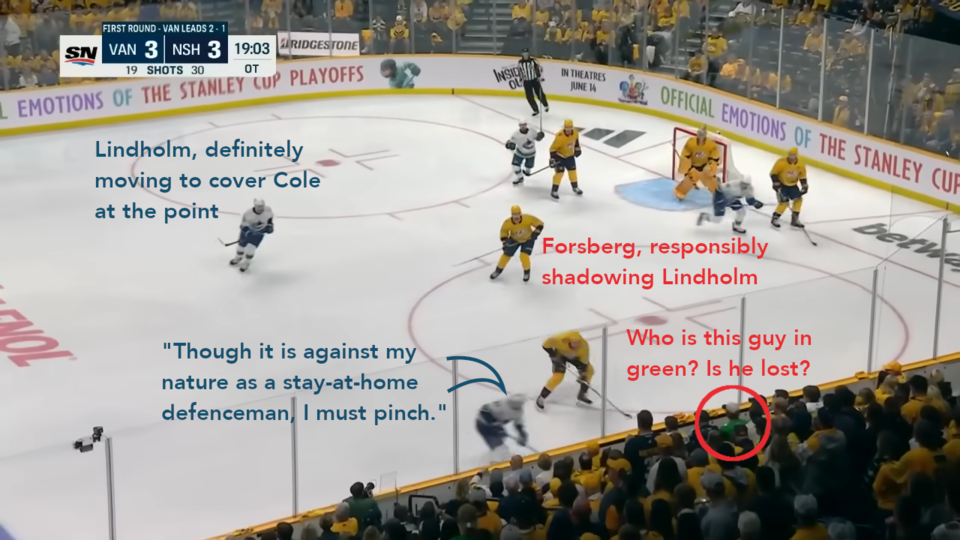
Hughes sends a puck toward the net but it goes wide, ringing around to the near boards. Cole pinches down from the point to beat O’Reilly to the puck and pokes it down the boards.
Meanwhile, Lindholm, who had cut into the slot looking for a rebound, circles back as Cole pinches, seemingly moving to cover for Cole at the point. That would be the responsible thing to do and Lindholm is nothing if not responsible.
Under Rick Tocchet, the Canucks drastically cut down on the number of 2-on-1s they gave up and a big reason why is how responsible their forwards have been in the offensive zone. They are constantly covering for pinching defencemen and staying above the opposing team’s F1. The one time they failed to do so in this game, the Predators got a 2-on-1 and scored.
With that in mind, it’s completely understandable that Forsberg would follow Lindholm out to the point. It means shifting from a zone defence to man-on-man and leaving the rails open but Forsberg is also hoping that O’Reilly can win the puck battle on the boards and he can be there to break the puck out. It also means Forsberg can comfortably lapse into his typical winger position on defence and let O'Reilly go back to playing centre.
Side note: who’s the dude in green? He’s surrounded by yellow on all sides and green is not a colour the Canucks have ever worn on the shoulder yoke. Is that a St. Patrick’s Day jersey? In the playoffs? Why are there people wearing green in the stands for this game?
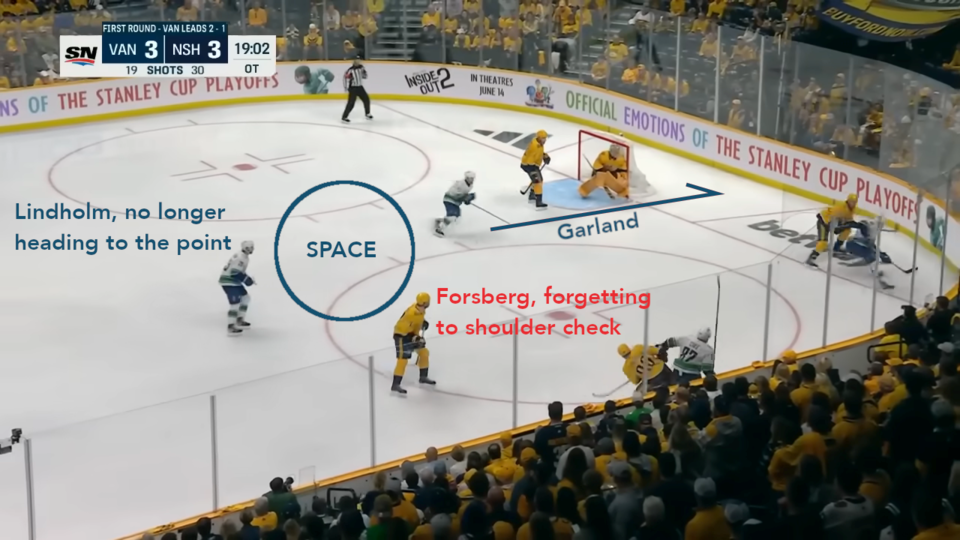
Uh oh.
As Cole pokes the puck down the boards, Lindholm turns back from the point and heads to the middle of the ice, where, for the first time all series, the Predators have left some space.
It’s a calculated risk for Lindholm. If any of the Predators wins the puck, they could move it up to Forsberg or Nyquist for a 2-on-1. At the same time, oh boy is that a lot of space.
Forsberg, however, only has eyes for the puck and completely misses that his man has changed direction behind him.
Garland, meanwhile, is already on the move. He knows for a fact that his best bud, Joshua, is going to be able to fend off McDonagh on the boards and keep that puck moving down low. That’s going to force Schenn to either stay in front and leave Garland time and space with the puck or to chase him behind the net, and leave the front of the net wide open.
Either option will suit Garland’s needs.
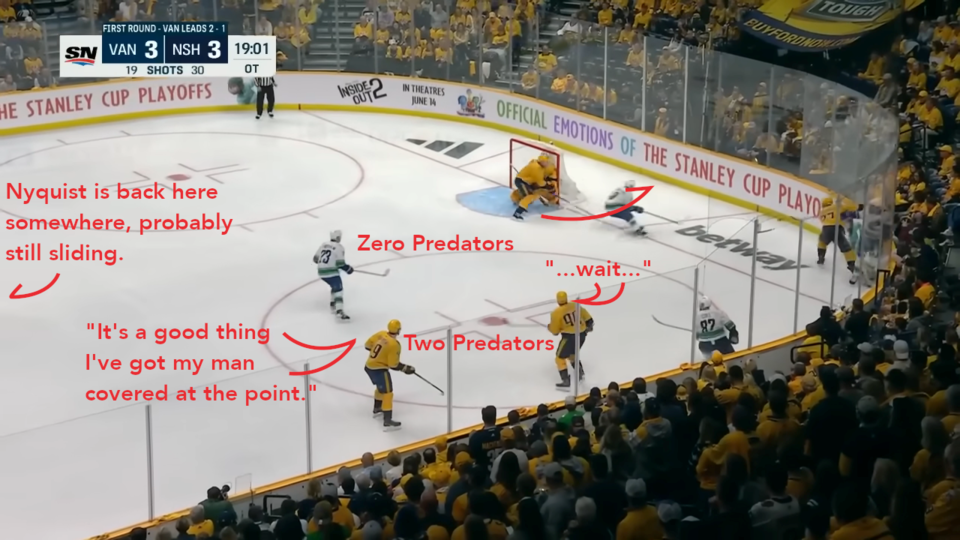
There goes Schenn.
Lindholm now has zero Predators between him and the net. Forsberg still hasn’t realized this, while it’s just coming to O’Reilly’s attention.
This is the most open any Canuck has been all series and it’s in overtime.
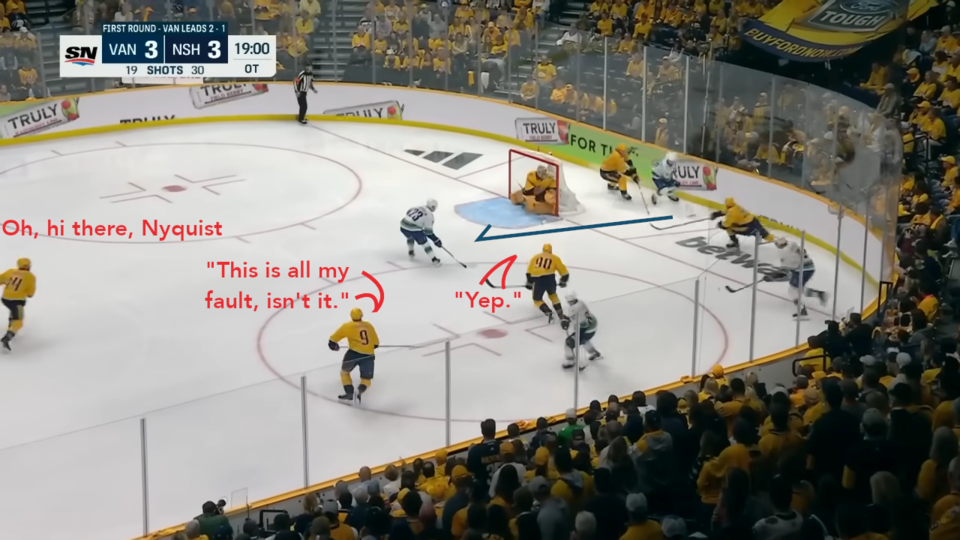
It’s not just that Schenn chases Garland but that he completely overplays him. Garland, as is his wont, cuts back as soon as he gets the puck and the slightly heavier-of-foot Schenn can’t stay with him, instead ending up entirely behind the net.
Schenn and McDonagh reach in to try to take away the passing lane but they can’t quite get there and Garland is able to thread the needle between their sticks.
Meanwhile, O’Reilly is trying to get to Lindholm but won’t get there in time, while Forsberg has finally realized that Lindholm is not, in fact, covering for Cole at the point but is instead in the most dangerous area of the ice.
Yes, Forsberg, this one is all your fault.
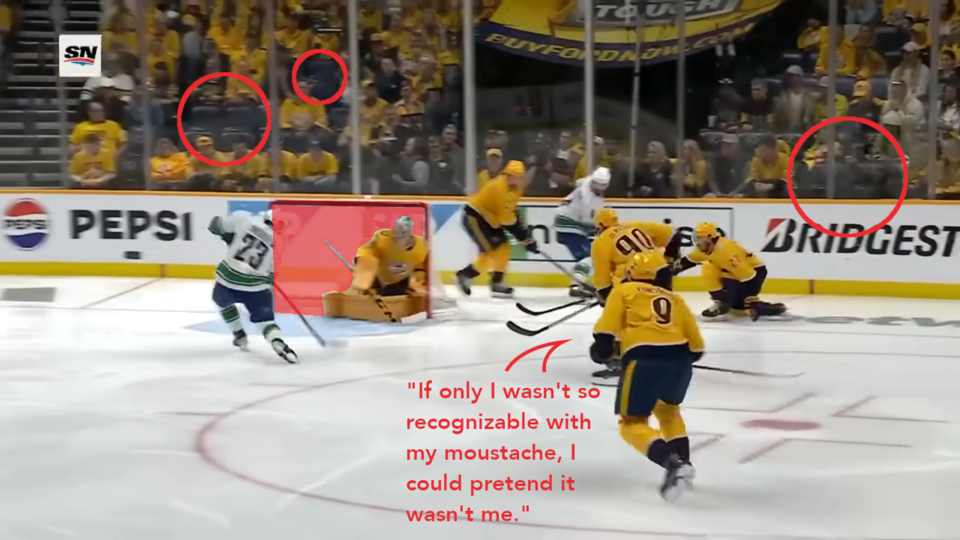
Lindholm ends up with just a little bit of net to shoot at, as Juuse Saros makes himself about as small as he possibly can. It’s actually kind of wild how much net is open for Lindholm.
There are definitely some empty seats behind Saros for what was reportedly a sellout crowd. Are those fans who went home early, assuming the Predators had this game in the bag? Did they make a bathroom or concession run during the intermission and didn’t make it back in time for the goal? Were they Canucks fans who had abandoned all hope and left early?
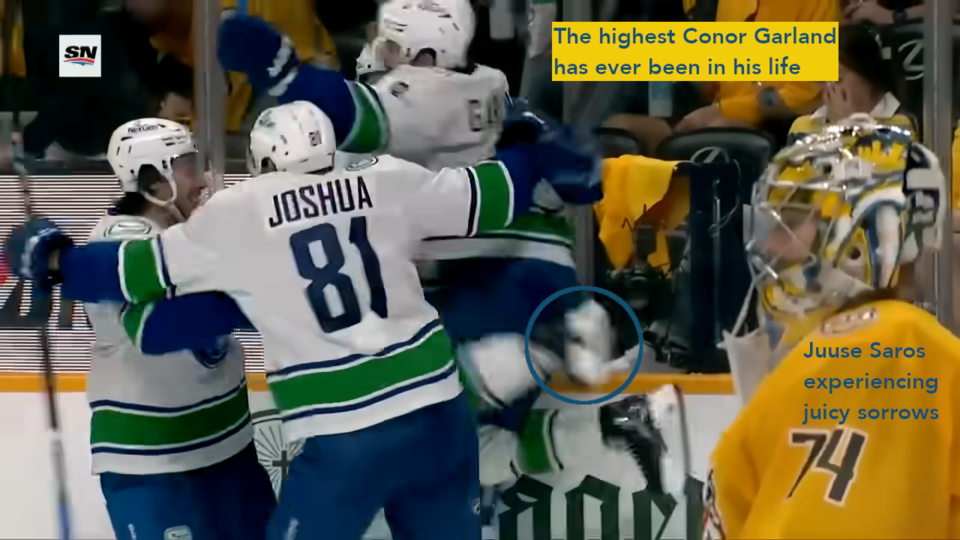
All that was left was the celebrations for the Canucks and the lamentations for the Predators.
Conor Garland sprinted into the goal celebration and leaped higher than likely even he believed was possible, getting his skate above the dasher.
In the background hangs a single, solitary rally towel — a pale imitation of the Canucks’ Towel Power left abandoned on a seat.
Poetry.

